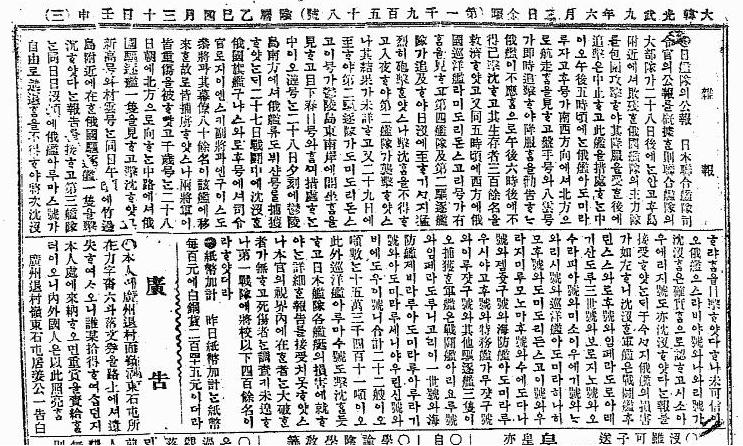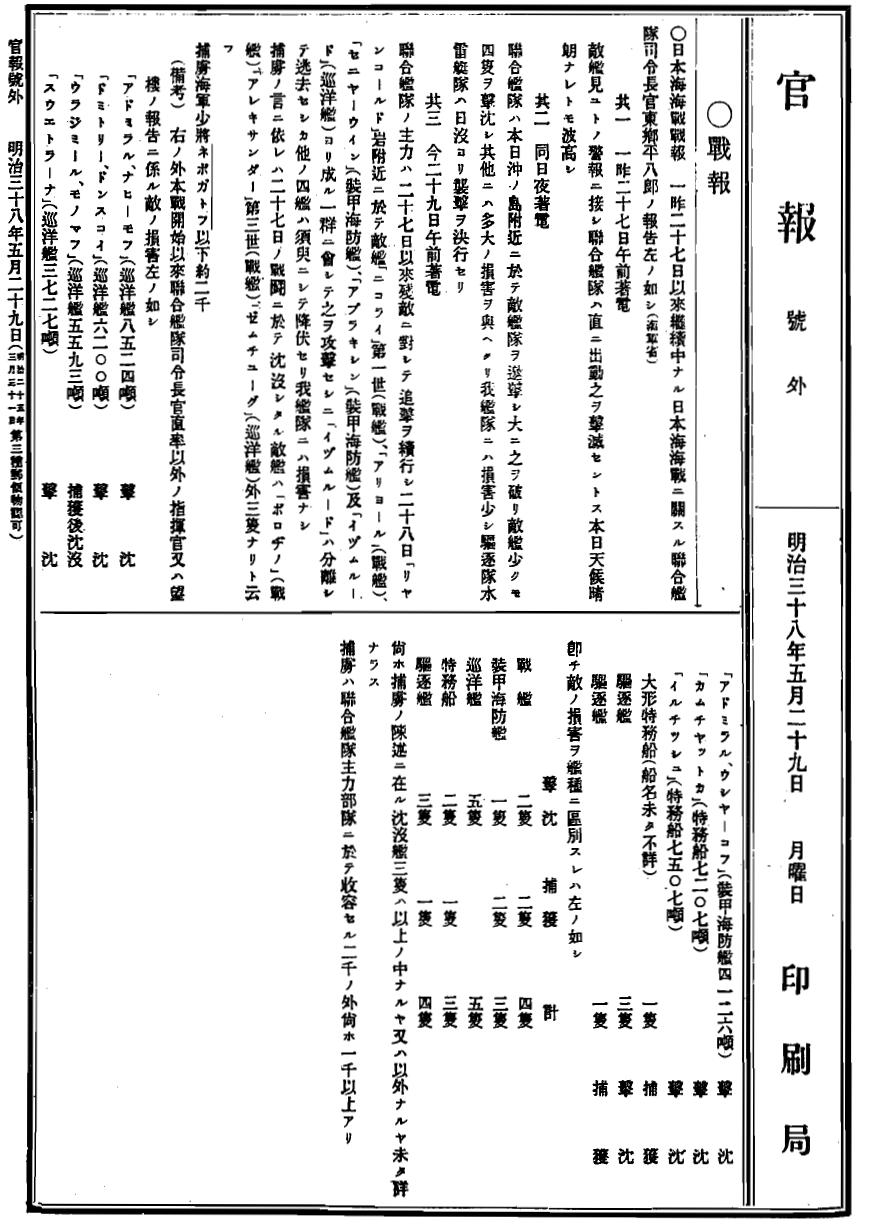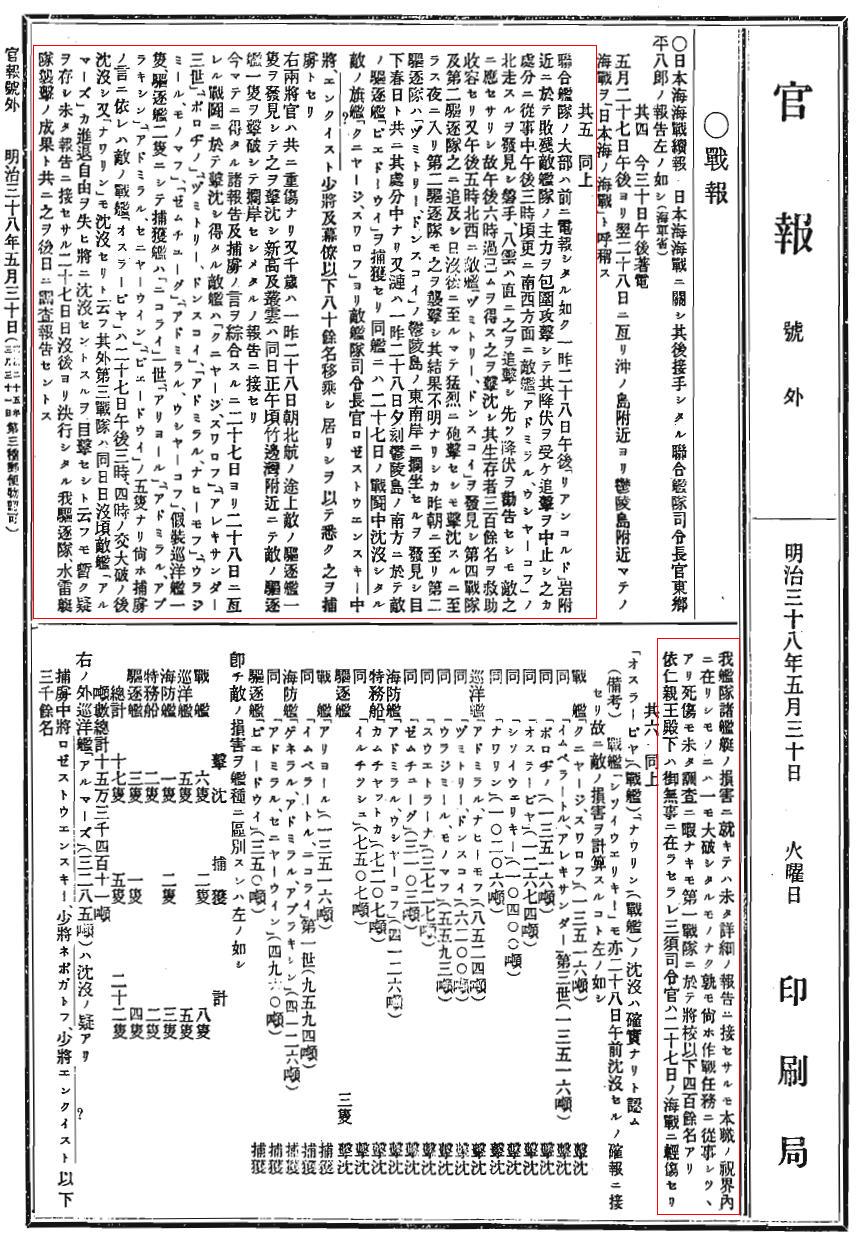To follow are the first part of June 2 1905 article of "Hwangseong Shinmun"(皇城新聞) , which seems to be the translation of 30th May, 1905 Japanese official gazette (官報 号外) about The Battle of Tsushima (Strait), commonly known as the Japan Naval Battle(日本海海戦) in Japan. This is the important historical primary resource which shows how Korean in 1905, the year Japan incorporated Takeshima/Liancourt Rocks into Shimane, actually called the island. All the documentations which shows how they called the island we found so far was Japanese resources, so it is the first time we confirmed Korean documents/evidence. And, it was Angohu島(island)=Liancourt Rocks which was same with Japanese, not Dokdo, Seokdo, Usando nor any other names Korean claim to be the old names for Takeshima/Liancourt Rocks afterall.
日艦隊의 公報 日本聯合艦隊司令官의 公報를 槪據한 則 聯合艦隊의大部隊가二十八日後에는 안고후島 附近에셔敗殘한俄國艦隊의 主力部隊를包圍攻擊하야 其降服을 受한 後에 追擊은 中止하고 此艦을 措處하는中이오
・・・・・・・・・・・・・・・・・・・・・・・・・・・・・・・・・・・・・・
The official dispatch of Japanese fleet. According to the general official dispatch of Japanese fleet, that is, A big unit of the Combined Fleet, after 28th, near the "Angohu(Yanko= Liancourt)" island, encircled and attacked the main force of defeated Russian fleet. And followed by the surrender of the enemy, they stopped the pursuing and in the middle of dealing with the ship...
The original Japanese Navy's war report was written under the name of famous Fleet Admiral Marquis Togo Heihachirou (東郷平八郎) and it was printed in official gazette(官報). Korean journalist mainly quoted article no.5 of the original. The original itself starts with the famous phrase "本日天気晴朗 ナレドモ浪高シ" written by Vice Admiral Akiyama Saneyuki (秋山真之). To follow is the part which coincides with the sentence above.
連合艦隊ノ大部ハ、前ニ電報シタル如ク、一昨二十八日午後、「リアンコルド」岩附近ニ於テ、敗残敵艦隊ノ主力ヲ包囲攻撃シテ、其降伏ヲ受ケ、追撃ヲ中止シ、之ガ處分ニ従事中、
・・・・・・・・・・・・・・・・・・・・・・・・・・・・・・・・・・・・・・
(As it was already transferred, the most of Combined Fleet had encircled and attacked the main force of remaining enemy ship corps defeated near at the Liancourt Rocks in the afternoon on 28th and after their surrender, it stopped the pursuing and now engaging the dealing with the aftermath. )
* Korean reporter mistranslated "大部" as "大部隊"
* Korean reporter mistranslated "二十八日午後" as "二十八日後"
* "リヤンコルド岩(Liancourt Rocks)" is translated as "안고후島" and altered "rocks" to "island" in Korean article.

Korean reporter seems to have translated article no.5 of Japanese Navy report basically, but actually, if you read the whole article, you will notice that he/she edited the original and had put more information they got from somewhere else since some parts of them were not in the original Japanese naval report. In other words, although writer did translated the Japanese report, he/she had collected more information and re-organized this article in his/her own perspective.
Interestingly and importantly, the writer of this article used "안고후(Angohu)島(island)", which was common name of the Takeshima/Liancourt Rocks (ヤンコ島 : Yanko-to)by Japanese and used by Korean as well around early 1900s, instead of "안고후(Angohu)岩(Rock)", the direct translation of the "リアンコルド(Liancourt)岩(Rock)" in the original Japanese war report. In other words, the writer changed the name of the island into the name it commonly known by. It is the concrete evidence that the writer of the article actually identified the island in concern is Liancourt Rocks(Yanko-to(ヤンコ島)), not only copied the name of the island, and also he/she knew that the island played the important role in the battle of the Tsushima.
Moreover, the reporter wrote Liancourt Rocks as "안고후島", which is the Korean pronunciation of "Liancourt Rocks", not "Dokdo(独島)", "Seokdo(石島)" nor "Usando(于山島)", all of which Korean claim as the other names of Takeshima/Liancourt Rocks. Japanese started to call Takeshima/Liancourt Rocks, which they used to call "Matsushima(松島)" in Edo era, as "Yanko(Liancourt)" island after Meiji restoration in 1867 when they got to know that the western name of the island on the map. And it is known that Korean, in 1904 warship Niitaka report, had wrote the island "Yanko-to/안고후島"(Liancourt Rocks) as "独島(Dokdo)". This 1905 article is important Korean own evidence that Korean still called Takeshima Liancourt Rocks as "Angohu-island", just like Japanese called Yanko-to.
And lastly, in Admiral Togo's original report, notice that he/Navy officers still used "リアンコルド岩(Liancourt Rocks)" instead of "竹島(Takeshima)" which they had already officially incorporated into Japanese territory and renamed as it is four months ago. Apparently, for Japanese officials, Navy, especially Admiral Togo and his brains had not placed much importance on incorporation of Takeshima from the strategical point of view. This implies Navy Captain / A chief of Hydrograhical Department, Kimotsuki Kaneyuki(肝付兼行) had no intention of "secretly" incorporating the island when he advised Japanese fishermen that the island had not been occupied by any other countries and it should be Japanese territory, in September 1904, unlike Mr. Naito Seichu and Prof. Hosaka keep claiming falsely without any concrete evidence.
These points confirm the fact that Korean in 1905 didn't consider Yanko-to/Liancourt Rocks/Takeshima/Dokdo as their own territorial island. And it also excludes the Korea's illogical claim that Japanese incorporation in 1905 was done secretly for the purpose of the accomplishment of Russo-Japan war. In fact, Japanese Navy started to construct watchtower on Takeshima/Liancourt Rocks in July and they started to use it in August, not before, but "after the Japan-Russo War.
During those days in 1903-1905, there were absolutely no newspaper article, official reports, requests, inquiry nor claims which object Japanese (Navy/civilian) activities on Takeshma/Lincourt Rocks from Korean at any level, including this article, which called "Angohu島", not Dokdo. It was not until Shim, the head of Ulleungdo mistook "Dokdo" as their territory, probably mysterious "Usando" which is believed to be 100-ris(40km) away from Ulleungdo, and reported the incident to his boss in mainland, which lead Korean central government require the survey of "the geography and population" of the island. This happened after he was told that Takeshima was now Japanese island, by the delegate group of Shimane prefecture who visited to Ulleungdo in 1906. If Takeshima/Dokdo had been truly their "inherent territory" and had "effective control" over the island in/before 1905 as Korean government currently claim, why they didn't even notice/claim about those open and spectacular war activities on /around Takeshima/Angohu島 by Japanese Navy, like they did about on Ulleugndo? In addition, civilian fishermen including Nakai built the huts and were hunting salions at least from 1903 and Korean definitely knew about Japanese economical activities. But still, there is absolutely no trace that Korean set any claim on them. Why?
I think it was simply because Korean, especially government officials in Seoul had no accurate nor precise information about Takeshima/Liancourt Rocks at all in the first place and didn't consider over Ulleugdo as Korean territory and thought Jukdo, the modern name of Usando, for the eastern limit of Korea, excluding this "Angohu Island/Liancourt Rocks/Yanko-to" from their territory in 1905. In 1882, Lee Gyu-won used the same name "竹島" with Japanese for Jukdo after Japanese MOFA identified Jukdo as 竹島(竹嶼) in 1881 based on Navy's survey. Although Korean had no accurate information on the whereabouts of Japanese Matsushima, they had simply swallowed the phrase "Usando is Japanese Matsushima",the lie Ahn Yong-bok started in 1696, and kept recording the phrase in the documents. Making the issue complicated, for Korean, Usan(Usanguk/Usando) was the name of Ulleungdo in ancient times. Moreover, Choson people hadn't visited Ulleungdo often since it was prohibited by the dynasty and the voyage was extremely dangerous for them, so they were not perfectly sure about the location of Ulleungdo and Usando and if those islands are two islands or one island with two names until 1711, when Bak Chang-seok's (朴昌錫) inspected Ulleungdo and labelled Jukdo as so-called Usando (鬱陵島圖形). After 1711, in most cases, Ulleungdo started to be recognised as it is today and Usando had been depicted as the neighbouring island of Jukdo(竹島 : Japanes pronunciation = Takeshima), but the Ahn's false calim still kept cited without any doubt in the documents. When they noticed that new Takeshima/Liancourt Rocks was old Matsushima in 1906, which they believed to be Usando, they again started to get confused as if Takeshima(Liancourt Rocks/old Matsushima) was Usando, which was the Korean name for Jukdo. However, in July that year, Korean Ministry of Interior officially answered Takeshima/Liancourt Rocks/Dokdo is outside of Uldo(Ulleungdo) County to the Japanese Resident-General . It is apparent that Korean had no recognition of Takeshima/Liancourt Rocks as their territory until 1950s. I believe Korean government are making use of this chain of misunderstandings and the confusion of names/locations of the islands which Korean had long held from ancient times.
In conclusion, from this article and the original Japanese Navy report, we are safely to conclude that Korean in 1905 did not have even slightest idea/recognition that Liancourt Rocks(Takeshima) was their territory. And the Korean claim that Japanese Navy secretly incorporated the island into Shimane for the purpose of the war is nothing but just a groundless accusation.
The basic idea of this post, writing of Japanese report and Korean article, Japanese translation of Korean article and the detailed analysis of whole report/article, all of them were done by our frequent commentator matsu. Though matsu translated and analysed whole article/report, I have to confess that I couldn't translate all of it. And the article itself was introduced by another commentator GTOMR. Thanks, guys !!



Reference :
1656 - "Yojiji (輿地志)" by Ryu Hyung-won (柳馨遠) didn't say "Usan is so-called Japanese Matsushima."
1692-1693 - The 1692 and 1693 incidents: Ahn Yong-bok's(安龍福) first visit to Japan
1693-1696 - The Takeshima incident(竹島一件): the 1st dispute between Japan and Korea
1696 - Ahn's so-called Matsushima/Usando was Jukdo, afterall. (元禄九丙子年朝鮮舟着岸一巻之覚書 肅宗実録 30卷, 22年 戊寅)1711 - Bak Chang-seok's (朴昌錫) Map of Ulleungdo (鬱陵島圖形)
1774 - Chungwanji (春官志): "Ulleungdo is called Sambongdo (三峯島)" ( "盖 是島 以其産竹也 故 謂 竹島 以有三峯也 故謂 三峯島 至於 于山 羽陵 蔚陵 武陵 礒竹 皆音 轉 訛而然 也" )
1881 - Kitazawa Masanari(北澤正誠), a official of MOFA concluded that "Takeshima" is Jukdo in "A Study of Takeshima (Takeshima Kosho 竹島考証) "
Lies, Half-truths, and Dokdo Video, Part 5 : "The King, Lee Gyu-won & Many Names for a Neighboring Island"
Korean Eastern limits described in various books exclude Takeshima/Dokdo from KoreanTerritory
1905 - January 28th: the decision to incorporate Takeshima in to Shimane by a Cabinet meeting (公文類集第29編 竹島編入閣議決定)
Wow!! Great job again Kaneganese!
ReplyDeleteIt is certain that Korea in late 19th century and early 20th century didn't think that Liancourt Rocks were their territory. All of the documents and maps indicate so.
So then, it is also apparrent that it was Rhee Syngman who did this international crime - stealing other country's islands and distorting history to cover it up.
Thank you Kaneganese,
ReplyDeleteI hope this 皇城新聞 article makes a good chance for further discussion.
And I will send an information about 1899 investigation of Ulleungdo by MOFA’s 高雄書記生 soon.
I also think it is interesting that the Korean reporter changed the name from "Angohu 'Rock'" (岩) to "Angohu 'Island'" (島). As Kaneganese pointed out, this is evidence that the Korean reporter did not just mindlessly translate the Japanese report, but changed the name to one that Korean readers would recognize.
ReplyDeleteThe fact that the Korean reporter did not use "Seokdo" (石島), "Dokdo" (獨島), "Usando" (于山島), or one of the other names Koreans claim was Liancourt Rocks is more evidence that Koreans did not consider the rocks to be Korean.
Sometime this week I will try to translate the full article into English. I hope some of our Japanese posters will help me with the many Japanese names.
Thanks, everyone.
ReplyDeleteGerry,
I'm going to paste the both reports and the comparison notation by matsu below. I translated his notation into English and put Japanese pronounciation of some proper nown as well.If you need more information, please let me know.
I hope it helps your translation and save some time. If you give us the English translation of Korean article, then I can use that to translate Japanese original report. It's much easier for me rather than translating from scratch.
皇城新聞 1905・06・02 雑報
(皇城新聞)日艦隊의 公報 日本聯合艦隊司令官의 公報를 槪據한 則
・・・・・・・・・・・・・・・・・・・・・・・・・・・・・・・・・・・・・・
(官報原文)連合艦隊ノ大部ハ、前ニ電報シタル如ク、一昨二十八日午後、「リアンコルド」岩附近ニ於テ、敗残敵艦隊ノ主力ヲ包囲攻撃シテ、其降伏ヲ受ケ、追撃ヲ中止シ、之ガ處分ニ従事中、
(皇城新聞)聯合艦隊의大部隊가二十八日後에는 안고후島 附近에셔 敗殘한俄國艦隊의 主力部隊를包圍攻擊하야 其降服을 受한 後에 追擊은 中止하고 此艦을 措處하는 中이오
*注
「大部」→「大部隊」
"Liancourd Rock(s)(リヤンコルド岩)" →「안고후(アンゴフ)島」
・・・・・・・・・・・・・・・・・・・・・・・・・・
(官報原文)午後三時頃、更ニ南西方面ニ敵艦「アドミラル、ウシヤーコフ」ノ北走スルヲ発見シ、盤手、八雲ハ直ニ之ヲ追撃シ、先ツ降伏ヲ勧告セシモ、敵、之ニ應セサリシ故、午後六時過、己ムヲ得ス之ヲ撃沈シ、其生存者三百余名ヲ救助・収容セリ。
(皇城新聞)午後五時頃에는俄艦아도미라루자고후号가南西方向에셔北方으로航走함을見하고盤手(Iwate)号와八雲(Yakumo)号가即時追撃하야降伏함을勧告하나俄艦가不應함으로午後六時後에不得己撃沈하고其生存者三百余名을救済하였고
*注
P.M. 3 → P.M. 5
"Admiral Oo-she-yah-kof" → 아도미라루자고후号
「アドミラル、ウシヤーコフ」を「アドミラル・ジャゴフ」とする
・・・・・・・・・・・・・・・・・・・・・・・・・・・・・・・・・
(官報原文)又、午後五時、北西ニ敵艦「ヅミトリー、ドンスコイ」ヲ発見シ、第四戦隊、及第二駆逐隊、之ニ追及シ、日没後ニ至ルマテ猛烈ニ砲撃セシモ、撃沈スルニ至ラス。
(皇城新聞)又同五時頃에西方에俄国巡洋艦라미도리돈스고리号가在함을見하고第四艦隊及第二駆逐艦除가追及하야日没에至학기까지猛烈히砲撃하얐으나撃沈함을不得하고
*注
Enemy vessel "Doo-me-tory Don-s-koi" → 俄国巡洋艦라미도리돈스고리号
・・・・・・・・・・・・・・・・・・・・・・・・・・・・・・・
(官報原文)夜ニ入リ、第二駆逐隊モ之ヲ襲撃シ、其結果不明ナリシカ、昨朝ニ至リ、第二駆逐隊ハ「ヅミトリー、ドンスコイ」ノ鬱陵島ノ東南岸ニ擱座セルヲ発見シ、目下、春日ト共ニ、其處分中ナリ。
(皇城新聞)入夜하야第二艦隊가襲撃하얐으나其結果가未詳하고
又二十九日에至하야第二駆逐隊가도미도리돈스고이号가鬱陵島東南岸에擱座함을見하고
目下春日号와함게措處하는中이오
*注
「第二駆逐隊」→「第二艦隊」
"Doo-me-tory Don-s-koi" → 가도미도리돈스고이号
・・・・・・・・・・・・・・・・・・・・・・・・・・・・・・・・・
(官報原文)又漣ハ、一昨二十八日夕刻、鬱陵島ノ南方ニ於テ敵ノ駆逐艦「ビエドーウイ」ヲ捕獲セリ。同艦ニハ、二十七日ノ戦闘中沈没シタル、敵ノ旗艦「クニヤージ、スワロフ」ヨリ敵艦隊司令長官ロゼトウエンスキー中将、エンクイスト少将、及幕僚以下、八十余名移乗シ居リシヲ以テ、悉ク之ヲ捕虜トセリ。右両将官ハ共ニ重症ナリ。
(皇城新聞)漣(Sazanami)号는二十八日夕刻에鬱陵島南方에셔俄艦류도뷔샨号을捕獲하얐는대
二十七日戦闘中에沈没한俄国旗艦구냐스와로후号에셔司令官로지이엔스키副将과엔구이스도将과其幕僚八十余名이該艦에移来한故로皆捕虜하얐으나 両将軍이皆重症을被얐고
*注
Enemy destroyer "Bee-ed-wi" → 俄艦류도뷔샨号
Enemy fleet commander/Vice Admiral Rozhdestvenskii, Rear AdmiralEnqvist → 司令官로지이엔스키副将과엔구이스도将
・・・・・・・・・・・・・・・・・・・・・・・・・・・・
(官報原文)又千歳ハ、一昨二十八日朝、北航ノ途上、敵ノ駆逐艦一隻ヲ発見シテ之ヲ撃沈シ、新高及叢雲(Murakumo)ハ、同日正午頃、竹邊湾附近ニテ、敵ノ駆逐艦一隻ヲ撃破シテ擱岸セシメタルノ報告ニ接セリ。
(皇城新聞)千歳(Chitose)号는二十八日朝에北方으로向하는中路에셔俄国駆逐艦一隻을見하고撃沈하얐고新高(Niiitaka)号와材雲(Zaiun?)号는同日午頃에竹邊島附近에在한俄国駆逐艦一隻을撃沉하얐다는報告을接하고
*注
「叢雲」→「材雲号」
「竹邊湾」→「竹邊島」
「撃沈」→「撃沉」
・・・・・・・・・・・・・・・・・・・・・・・・・・・・・・・・・
So far, the report is almost direct translation of Japanese reports no.5, except for some mistakes. (Hence,「안고후(アンゴフ)島」is almost certainly a translation of 「リアンコルド岩」.) However, from here, the report run off the no.5 of original.
(皇城新聞)第三艦隊는同日日没頃에俄艦아루마스号가自由로進退함을不得하야将次沈没하얐함을目撃하얐다하나未可信이오
(supposed related part of original)第三戦隊ハ、同日日没頃、敵艦「アルマーズ」カ、進退自由ヲ失ヒ、将ニ沈没セントスルヲ目撃セシト云フモ、暫ク疑ヲ存シ、(うしろから4行目)
(皇城新聞)俄艦으스라비야号와나와리号가沈没함은確実함으로認하고시소아으에라지号도亦沈没하였다는報을接受하얐는데
(supposed related part of original)
其六「オスラービヤ」(戦艦)、「ナワリン」(戦艦)ノ沈没ハ確実ナリト認ム。
(備考)戦艦「シソイウエリキー」モ亦二十八日午前沈没セルノ確報ニ接セリ。
・・・・・・・・・・・・・・・・・・・・・・・・・・・・・・・・・・
(皇城新聞)于今까지俄艦의損害가如左하니
沈没한軍艦은
戦闘艦후린스스와로후号와임페라도로아레기산도루三世号와보로지노号와오수라피아号와 미소이우에기号와나와리시号와
巡洋艦아도미라히나히모후号와도미도리든스고이号와우라지미루모노마후号와수에도다나 号와젬줏구号와
海防艦아도미라루우시야고후号와特務艦가무쟛구号와 이루쟜구号其他駆逐艦三隻이오
捕獲한軍艦은 戦闘艦아리요루号와 임페라도루니고리이一世号 海防艦제비라루아도미라루아루라기号와 아도비라루세니야우린신号와 비에도우이号니
合計二十二艘이오 噸数는十五万三千四百十一噸이오 此外巡洋艦아루마수号도撃沈한듯하고
*注
This is the summerization of No.6 of the original report
・・・・・・・・・・・・・・・・・・・・・・・・・・・・・・・
And the last is from the last part of No.5, again.
(皇城新聞)日本艦隊各艦艇의損害에就하야난詳細한報告를接受치못하얏스나本官의視界内에在한者는大破한者가無하고 死傷者는調査키未邊하나第一戦隊에将校以下四百余名이라하얏더라
(related part of original Japanese report)我艦隊諸艦艇ノ損害ニ就キテハ、未ダ詳細ノ報告ニ接セサルモ、本職ノ視界内ニ在リシモノニハ、一モ大破シタルモノナク、孰モ尚ホ作戦任務ニ従事シツツアリ。死傷モ未タ調査ニ暇ナキモ第一戦隊ニ於テ将校以下四百余名アリ。
拝見しました。と言っても冒頭の部分だけですが。皆さん御苦労様です。
ReplyDeletechaamiey
This comment has been removed by the author.
ReplyDeleteKaneganeseさんの投稿本文の皇城新聞の記事が「二十八日後에는난 안고후島」となっていますが、「난」 は何かの間違いですね。コメントに書かれた文の方が正しいです。
ReplyDeleteしかしアンゴフ島ですか・・・・・初めて聞く名前です。
長音記号で「アンゴー島」とすべきでしょうか?
ReplyDelete材雲は「村雲」の誤字でしょうが、「村」だと思って見ると「村」にも見えるような?
chaamieyさん
ReplyDeleteおっしゃる通りです。
kaneganeseさんとのやりとりの中で、古い字体の는の「ア」を転写する時に「난」とするか「는」とするか迷っていて「난」が残ってしまいました。
kaneganeseさん、「난」は削除してください。
小嶋日向守さん
안고후をアルファベット転写する時には、「후」はどうなるのでしょうか?
Angohu はやはりへんで、
Angou でしょうか?
それとも思い切って
Angooになるのでしょうか?
大変興味深い、意義深い発見だと思います。日本の外務省もこの事実を知っていると良いのですが…。
ReplyDeletechaamieyさん
ReplyDeleteご指摘ありがとうございました。
matsuさん
修正しました。失礼しました。
ありがとうございました。
ReplyDeleteこの文書がGTOMRさんによって発見された Saturday, August 23, 2008付け
「1907 新編 大韓地理」のコメント(いちばん下のほう)にも書きましたが、
官報の原文とこの皇城新聞の記事のあいだには、ソウルで読むことのできた、この官報を記事として伝える、日本語の新聞か何かがあったのだと思っています。
東郷平八郎司令長官が、竹島編入後のこの時期にも、「リアンコルド岩」と呼んでいるのはなぜか、というのは、非常に「魅力的な謎」だと思います。
韓国側は、日本海海戦を伝える各種新聞記事が「リアンコルド岩」と書いていることをもって、日本が竹島編入を秘密にしていたのだ、という議論をしていますが、「官報」というメディアをもって「リアンコルド岩」は「竹島」、と明らかに訂正していることからすれば、(上に貼り付けられた3枚の官報記事の一番右の下段のまんなか)その説はなりたちません。
matsuさん
ReplyDelete”韓国側は、日本海海戦を伝える各種新聞記事が「リアンコルド岩」と書いていることをもって、日本が竹島編入を秘密にしていたのだ、という議論をしていますが、「官報」というメディアをもって「リアンコルド岩」は「竹島」、と明らかに訂正していることからすれば、(上に貼り付けられた3枚の官報記事の一番右の下段のまんなか)その説はなりたちません。”
大変重要なご指摘です。後日、この官報についてもまとめようと思っていますので、その節はご協力お願い致します。思いついた事をメモ代わりにコメントしていただいていても結構です。
matsuさん、
ReplyDeleteアンゴフ島の「ゴ」はひょっとして「꼬」に見えませんか? 原音は「C」なのでこっちの方が似つかわしいと思うのですが。
chaamieyさま
ReplyDelete確かに、꼬のようにも見えますね。
なにせ薄いので。。。
やっぱり고にも見えるし。。。
꼬だと「アンコフ島」ですね。
myCoreeさんは、最初の(Saturday, August 23, 2008付けコメント)では
안고후と読んでいましたね。
皇城新聞は、当時の「本物」というものを見たことがなく、復刻版でしか見られないので悩ましいです。
ネットにあがっているのも、みな復刻版からだと思います。
99・09・23の時も、最後が良く読めませんでしたし、前回Gerry Bevers さんが紹介した03・03・30の時も、薄かったですね。chaamieyさんは、よくあれだけ読んだと思いますが。
안고후の「후」についても、「てふてふ」と「ちょーちょー(蝶々)」の関係のように、書いてある通りに転写するのがいいのか、発音を考えたほうがいいのか、英語として表現するときには、難しいですね。
matsu様
ReplyDeleteそうですね。
ローマ字で表記するのは訳者の裁量で自由かもしれません。
Angoh Angowなどもあり得ましょうし、あるいは
Angô と基本的な表記の方が良いのかも知れません。
日本語の場合では、例えば、「扇」を仮名で「あふぎ」と書いてあっても
「おうぎ」と読み、それに準じて、ローマ字を書きますよね。
判断を誤りがちなのは、「仰ぐ」を「あふぐ」と書いてあっても、この読みは、「あおぐ」では本来は、間違いとなるので、「おーぐ」または「おおぐ」としなければならないことなどですね。
表音文字の欧米語に訳すわけですから、発音重視が基本にしても、なかなか難しいものです。
私はこのサイトを訪れる人が、この記事を何処かに引用するとき、「アンゴフ島」と日本語で書くのは、不正確かと思っただけです。
小嶋日向守さま
ReplyDeleteありがとうございます。
それでは、まあ、とりあえず、書いてある通りに転写しておく、ということでしょうか。
Angohu とか 「アンゴフ」とか書くと、どうも「ヤンコ」から離れてしまうので悩ましいのですが、やはりこの「안고후島」は、「ヤンコ」系の名前だと思います。
島名の部分を拡大してみましたが、私はやはり「꼬」だと思います。それで私は今後は「アンコフ島」と書くことにします。
ReplyDeletehttp://img.blogs.yahoo.co.jp/ybi/1/66/88/chaamiey/folder/1585665/img_1585665_18537106_3?1222447849
hamburgerは日本語ではハンバーガー、韓国語ではヘンボゴ、MacArthurは日本語ではマッカーサー、韓国語ではメガドという違いがあることは良く言われることですが、「Liancourt」は韓国人にはどう聞こえてどう表記するんでしょうかね。
想像して見るに、まず「ランコル」か「ランクル」と聞こえたのではないでしょうか。
それを表記しようとすれば、まず語頭のR音は慣例によって省略されます。それで「アンコル」、「アンクル」となります。次に「ク」か「コ」かについては、彼らには「コ」に聞こえたのでしょう。それで「アンコル」です。
最後に「ル」ですが、フランス語の「メルシー」などは聞きようによって「メルシー」とも「メフシー」とも聞こえます。韓国人にどう聞こえるのかか知りませんが、リアンクールの場合、「フ」の方を採用したという可能性が考えられます。そうすると、結局、
「ランコル」→「アンコフ」が成立します。
というわけで、「アンコフ」はまさに「Liancourt」の(少なくともその当時では)韓国語表記だったのでしょう。
「アンコフ」を日本語あるいは英語で何と書いたら良いかということについては、ハングル文字の表記を尊重して「アンコフ」「Ankofu」と書くしかないと思います。
皆さん
ReplyDelete杉野洋明氏が、この新聞記事の一日前のものを掲載しています。
★本邦初公開?日本海海戦時、竹島は韓国で何と呼ばれていたか?
彼によると、皇城新聞は「ジウンコルド巌」と訳していたようです。これはおそらく、この「リヤンコルド岩」が通称「ヤンコ島」であると韓国人記者が判断して안고후島と書き直したのではないでしょうか?どう思われますか?
6月1日の皇城新聞記事は、明治38年5月29日官報掲載の日本海海戦戦報其三の"「リアンコールド」岩"の訳ですね。
ReplyDeletechaamieyさん
"というわけで、「アンコフ」はまさに「Liancourt」の(少なくともその当時では)韓国語表記だったのでしょう。"
29日の其三"「リアンコールド」岩"とは、一字の違いがありますが、私はこの記事の記者は、Liancourt Rocks/「リアンコルド」岩ではなく、通称「ヤンコ島」の発音を韓国語表記したのではないかと思います。6月1日の「ジウンコルド巌」は、「リアンコールド岩」の訳で正しいでしょうけれど。
皇城新聞 dated on 1Jun1905
ReplyDeleteThese days I had serched another report about Linacourt Rocks and Battle of Tushima and I had also read this page, but I fail to find the text about Liancourt Rocks which Nidanosuke suggested.
Kaneganeseさん
ReplyDelete6月1日は「ジウンコルド巌」(あるいはチウンコルド巌)で、6月2日には「アンコフ島」ですか。何でそんなに違うんでしょうか。謎ですね。
記者はこのときに初めてLiancourd Rocks というものを認識したので、表記が定まらなかった、ということでしょうか。
しかし、「ジウンコルド巌」という言葉がどこから来たのかは見当がつきません。
chaamieyさん
ReplyDelete"記者はこのときに初めてLiancourd Rocks というものを認識したので、表記が定まらなかった、ということでしょうか。"
"しかし、「ジウンコルド巌」という言葉がどこから来たのかは見当がつきません。"
「ジウンコルド巌」は、リアンコールド岩の直訳では無いでしょうか。そして、その時点では記者はどこの島であるか分からなかったものの、翌日の戦報も合わせ読んで「リアンコールド岩」が通称「ヤンコ島」である事を確認し、「アンゴフ/アンコフ/アンコー島」とより正確に表記したのではないかと思います。他に説明が付かないと思いますが、如何でしょうか。皇城新聞の記者がヤンコ島と言う通称を知っていたと言う事実があるかどうかは別問題ですが。
試訳です。
ReplyDelete日軍の公報
日本聨合艦隊司令長官の報告に概拠するに、すなわち、
日本聨合艦隊の主力隊が、本月二十七日、沖島附近にて、ロシア艦を激撃し、
ロシア国戦闘艦ブロジノ号と、亜歴山(アレキサンドル)三世号と、巡洋艦ケムシュック号、以外三隻を撃沈し、
又、日没後に、駆逐水雷艇が、ロシア艦を襲撃し、陸続、追撃し、
二十八日に、チウンコルド巖附近にて、ロシア艦ニコライ一世号と、アリヨル号と、セニヤウイン号と、ヤスラギシン号と、イスムルド号に逢い、
ロシア艦イソムルド号は逃去し、其他四隻は投降し、
日艦は、損害が無いとのこと。
これをみると、「官報」の「其三」をそのまま翻訳したのではなく、「其二」の情報も入っており、かなり再構成していることがわかります。
Kaneganeseさん
ReplyDelete>「ジウンコルド巌」は、リアンコールド岩の直訳では無いでしょうか。
「リアン」が「ジウン」(またはチウン)と表現される事情が分からないので、今のところ直訳とは言い難いと思っています。まあ、リアンクールを意味するものではあるのでしょうけどね。
それから、「アンコフ島」は「ヤンコ島」の訳ではないかという点については、やはり「フ」という言葉が説明できないので、どうかなあというところです。
ReplyDeletechaamieyさん
ReplyDelete私は韓国語が分からないので、何とも言えませんが、他の皆さんのお話では、アンゴフもしくはアンコフと表記してアンコー/アンゴーと発音するのではないんですか?リアンコールド岩を「ジウンコルド巌」としたように、表記のゆれはあったように思いますが。
matsuさん
ReplyDelete訳していただいてありがとうございます。確かに、其三だけではないようですね。実に面白い。
Kaneganeseさん
ReplyDelete古くからある言葉ならば自然に音変化が生じるということがあるかも知れませんが、この場合は外国語を自国語で表記しようというわけですから、発音を考えて、発音するとおりに書くと思います。
chaamieyさん
ReplyDelete"最後に「ル」ですが、フランス語の「メルシー」などは聞きようによって「メルシー」とも「メフシー」とも聞こえます。韓国人にどう聞こえるのかか知りませんが、リアンクールの場合、「フ」の方を採用したという可能性が考えられます。そうすると、結局、「ランコル」→「アンコフ」が成立します。""この場合は外国語を自国語で表記しようというわけですから、発音を考えて、発音するとおりに書くと思います。"
しかし、この場合はリアンクールではなく、リアンコルド岩の訳なので、chaamieyさんの矛盾するようです。其三のリヤンコールド岩を「ジウンコルド巌」とした事の説明にもなりません。明らかに発音通りでは無いですから。
Kaneganeseさん
ReplyDelete皇城新聞の記者が「リアンコルド岩」と書いてある日本の文書をもとにして記事を書いたとしても、「リアンコルド岩」という日本語のカタカナ表示を直訳したのか、それとも、「リアンコルド岩」の原語である「Liancourt Rocks」を訳したのか分からないので、なかなか判断しにくいですね。
私は「アンコフ島」という翻訳の結果から考えれば「Liancourt Rocks」を訳した可能性が高いんだろうと考えています。「岩」が「島」に置き換えられているという点はありますけどね。
「ジウンコルド巌」(チウンコルド巌)(ジもチもハングルでは同じ文字です)は、先に書いたとおり謎です。
あえて推測を書くならば、これは「リアンコルド岩」という日本語のカタカナを直訳したのだけれども、「リア」の部分が印刷不鮮明か何かのために「チウ」というカタカナだと読み誤り、その結果、「チウンコルド岩」と理解してそれをハングルに置き換えたという可能性が考えられます。
chaamieyさん
ReplyDeleteしつこいようですみません。
”私は「アンコフ島」という翻訳の結果から考えれば「Liancourt Rocks」を訳した可能性が高いんだろうと考えています。「岩」が「島」に置き換えられているという点はありますけどね。”
chaamieyさんは、もし当時の韓国人が「Liancourt Rocks」の名称をどこかで確認したとするならば、どういったソースを想定されますか?ご存知のように、西洋の地図には、「Liancourt Island」 と表記しているものもあります。私が考えるようにヤンコ島の音読表記ではなく、もし彼等が地図をみて「Liancourt Island」をアンコフ島と音読表記したのなら、話はさらに重要性を帯びると思います。つまり、現竹島の正確な位置を地図上で把握していながら、石島・于山島・独島など韓国側の通称とされているこれらの名称を使用しなかったことになります。
いずれにせよ、もっと他の資料の検討が必要ですね。実は、matsuさんから明治三十八年五月ニ十九日付の時事新報の日本海海戦戦報記事のコピーをいただきました。当時、こうしたものがソウルにも送られ、韓国人が目にしていた可能性が十分にあると思います。他の現地発行の日本語新聞なども詳しく伝えていたはずですよね。
Someone please advice if there are some interesting text or not inside it?
ReplyDeleteGTOMRさん、その文章はロシア水兵の戦闘体験談であり、舞台は船内なので、竹島に関する記述はありません。
ReplyDelete戦闘の修羅場のほか、捕虜になったあとに日本軍から受けた待遇が良かったとか、日本軍はロシア軍と違って上官と部下の関係が良い、などと書かれています。
2009.07.09
chaamiey 様
ReplyDelete有難うございました。
25日の日付の記載は有るものの、27日とかの日付の記載がないので、見落としたのか、それとも全く鬱陵島・竹島関係がないのか判らないままでした。